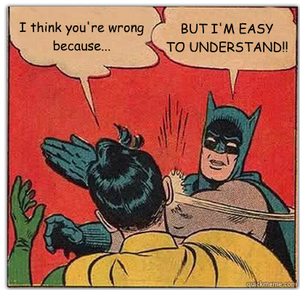By Dr. Ken Broda Bahm:

It happens sometimes in an argument: You know the claim you’re hearing is false, but you also know that it sounds like it could be true, and it’ll be a lot harder to refute the argument than it was to make it in the first place. Measured in time and effort, your adversary’s initial argument is quite cheap while your response to it is very expensive. That difficulty is common in litigation, where truth is often on the side of the involved and analytical explanation rather than on the side of the compelling yet simplistic claim. Responding to that situation takes some care. Rather than just hoping your audience can follow the complexity, or giving up and becoming just as glib as your adversary, the trick is to help your listeners rise to the challenge. The trick is to use good teaching to make your explanation as simple as possible without being simplistic.
I’d like to use a current political example to illustrate both the problem and the solution. Through the 2012 Presidential election and beyond, we’ve seen continuing argument over the Affordable Care Act, also referred to (either derisively or admiringly) as “Obamacare.” The new argument to emerge in the last couple of weeks is that Congress is trying to exempt its own staff from the ACA mandates. Attributing the story to “sources in both parties,” Politico on April 24th noted, “high-level, confidential talks about exempting lawmakers and Capitol Hill aides from the insurance exchanges they are mandated to join as part of President Barack Obama’s health care overhaul.” Based on this story, “they risk being dubbed hypocrites by their political rivals and the American public.” Yes, they certainly would risk that. If Congressional Democrats were to apply the law to everyone except their own staff, it looks like both an admission of the Act’s flaws as well as an appeal for special favors. The reality, however, is a lot more complicated and Annenberg’s Pulitzer Prize-winning FactCheck.org has labeled the claim “false.” The problem is that the reasons why it is false require a bit of explaining. This post uses this curent political argument as an example of the kinds of argument seen in litigation, where a charge is easily made, yet the refutation is difficult.
Obamacare and the Great Escape
 When the story surfaced that Congressional Democrats wanted Obamacare to apply to all of America other than their staffs, that immediately created a very simple argument that could be boiled down to a quick news bite or a social media meme, like this one. Acknowledging that the real story is a little more complicated and a lot less interesting, the New York’s Times‘ Ezra Klein carefully walks readers through the longer explanation, but definitely ends up with the conclusion (buttressed by the Annenberg fact check noted above) that Congress is not exempting their own staff from the ACA.
When the story surfaced that Congressional Democrats wanted Obamacare to apply to all of America other than their staffs, that immediately created a very simple argument that could be boiled down to a quick news bite or a social media meme, like this one. Acknowledging that the real story is a little more complicated and a lot less interesting, the New York’s Times‘ Ezra Klein carefully walks readers through the longer explanation, but definitely ends up with the conclusion (buttressed by the Annenberg fact check noted above) that Congress is not exempting their own staff from the ACA.
The story of what really happened is better told in steps:
Chapter One: The Setting. Congressional staff have a great policy to cover their health care. Unlike millions of Americans, they get a comprehensive health insurance plan for themselves and their families, with 75 percent of the premiums paid by the government.
Chapter Two: The Negotiation. The specific terms of the Affordable Care Act are worked out in Congress. In the process, the new policy is actually modeled after the program that members of Congress and their staffs already have.
Chapter Three: The Dare. Congressional Republicans have the idea to embarrass Democrats by floating an amendment that would force congressional staff to lose their insurance and go into the exchanges instead. In effect, the Republicans are saying to their colleagues across the aisle, “I dare you to oppose this…”
Chapter Four: The Calling of the Bluff. In a strategic move to deprive their adversaries of a talking point, Democrats signal their loyalty to the bill by embracing that amendment and making it a part of the new Affordable Care Act.
Chapter Five: The ‘Oops’ Moment. Even as they chose to change the law to require their staffs to enter the insurance exchanges, Congress apparently forgot about the 75 percent contribution that the government previously made to the staff’s premiums. So the law as written would now quadruple their staff’s health care expenses, not because Obamacare is expensive, but because the government is no longer contributing.
Chapter Six: The Cheap Shot. To save their staff, Congress tries to fix the law in order to prevent this large increase, leading the law’s critics to charge hypocrisy: “They found out Obamacare quadruples their costs, so now they want to be exempt.”
That is it in a nutshell. For those who take the time to understand the six chapters, the charge of hypocrisy is a clear case of political opportunism that is strongly at odds with the facts. But for those who just hear the charge without understanding the context, it sounds like a devastating and simple critique of both the law and of Washington culture. That problem has its parallels in litigation. The single line from a smoking-gun email message, for example: It may read horribly on face, while being much more innocuous in the context of the full story. But how do you get jurors to consider the whole story?
Even the Playing Field
______
Other Posts on Rejoinder:
- Don’t Let Your Judge Reduce You to Absurdity
- Avoid the “And Another Thing…” Style in Rebuttal
- Expert Witnesses: When Criticized, Don’t Just Respond, Riposte!
______
Image Credit: Created via Quickmeme.com, captioned by the author